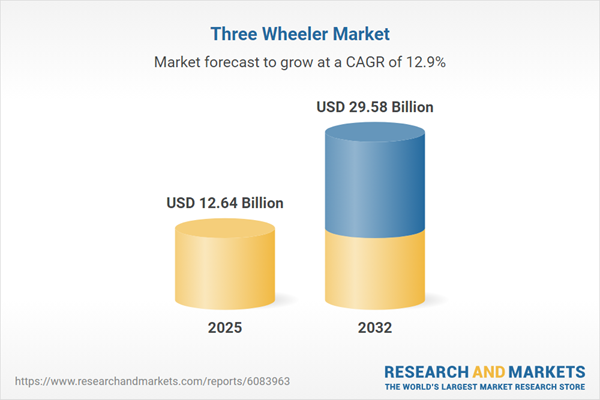Speak directly to the analyst to clarify any post sales queries you may have.
The three wheeler market is experiencing a pivotal transition, driven by fundamental shifts in regulatory environments, adoption of advanced technologies, and evolving consumer and fleet preferences. Senior leaders must adapt to this landscape to position their organizations for sustained success in the next era of urban and commercial mobility.
Market Snapshot: Three Wheeler Market Size and Growth
The Three Wheeler Market expanded from USD 11.19 billion in 2024 to USD 12.64 billion in 2025. Maintaining a robust growth trajectory, the sector is projected to reach USD 29.58 billion by 2032, corresponding to a compound annual growth rate (CAGR) of 12.91%.
Scope & Segmentation
This report delivers extensive insight into the global three wheeler market, with a strategic lens on emerging technology adoption, impact of regulatory changes, and varied operational models. It equips decision-makers with comprehensive perspectives across critical domains:
- Fuel Types: Analysis includes CNG, diesel, LPG, petrol, and electric models, with distinctions made between key battery categories: 5 to 10 kWh, below 5 kWh, and above 10 kWh systems.
- Vehicle Types: Market segmentation encompasses goods transport (including heavy goods and light goods applications) as well as passenger services, differentiated by individual versus shared transport solutions.
- Seating Capacities: Coverage spans one-seater, two-seater, three-seater, and four-seater configurations, supporting diverse usage scenarios and route flexibility.
- Power Output: Vehicles are classified by capability ranges: below 10 horsepower, from 10 to 20 horsepower, and above 20 horsepower, enabling effective matching to urban and peri-urban requirements.
- Ownership Models: The report evaluates commercial domains (such as fleet operators and individual business owners) alongside trends in personal use, highlighting operational and investment implications.
- Regions: Geographical coverage includes the Americas (with focus markets such as the United States, Brazil, and Mexico), Europe and Middle East & Africa (including developed and emerging economies), and Asia-Pacific (covering China, India, Southeast Asia, and more), enabling recognition of regional priorities and adoption patterns.
- Companies Covered: Detailed strategic analysis on Bajaj Auto Limited, Piaggio & C. S.p.A., Mahindra & Mahindra Limited, TVS Motor Company Limited, Atul Auto Limited, Force Motors Limited, Kinetic Green Energy & Power Solutions Limited, Lohia Auto Industries Private Limited, Piaggio Vehicles Private Limited, and Mahindra Electric Mobility Limited.
Key Takeaways for Senior Leadership
- Electrification, combined with modular digital solutions, is reshaping vehicle development and influencing design for enhanced adaptability and longevity.
- Consumer preference and demand drivers are highly region-dependent, with metropolitan markets placing emphasis on sustainability and compactness, while cost efficiency sustains momentum for legacy fuel types in certain areas.
- Regulatory mandates, including emission standards and clean energy requirements, are catalyzing investment in greener technology and modifying OEM and fleet operator strategies across value chains.
- Operational models increasingly integrate telematics and IoT, enabling real-time fleet management, preventive maintenance, and productivity gains for large and small operators alike.
- Supply chains are being recalibrated, emphasizing local content integration and diversification of sourcing in response to trade regulation and policy changes, strengthening organizational resilience.
- Segmented innovation—addressing differing seating, battery, and output needs—unlocks new opportunities for tailored product development and penetration into underserved regional niches.
Tariff Impact on Strategy and Supply Chains
Adjustments to tariffs in the United States have driven manufacturers to reconsider sourcing tactics, supporting a pivot to regional suppliers across Southeast Asia and South America. This approach not only helps stabilize production costs but also reduces vulnerability to trade risks and logistical disruptions. An increased focus on local content further enhances operational agility and lowers dependence on concentrated supply sources.
Methodology & Data Sources
The analysis employs a dual approach: primary insights from executive and fleet manager interviews and secondary research leveraging regulatory filings and technical documentation. Scenario modeling ensures that both qualitative perspectives and quantitative trends are objectively reflected for balanced, practical findings.
Why This Report Matters to B2B Decision-Makers
- Empowers executive teams to anticipate and act on technology trends and regulatory developments, safeguarding mobility strategies and capital allocation.
- Offers nuanced analysis of segmentation and regional disparities, equipping leaders to craft market entry and competitive positioning tactics.
- Delivers actionable frameworks for addressing supply chain disruptions, integrating digital capabilities, and fostering partnerships aligned with industry shifts.
Conclusion
As regulatory requirements and technology strategies advance, sustained market relevance demands continuous alignment between innovation and operational agility. Leaders who proactively integrate these dynamics will be well positioned to secure competitive advantage in the evolving three wheeler sector.
Table of Contents
3. Executive Summary
4. Market Overview
7. Cumulative Impact of Artificial Intelligence 2025
List of Figures
Companies Mentioned
The companies profiled in this Three Wheeler market report include:- Bajaj Auto Limited
- Piaggio & C. S.p.A.
- Mahindra & Mahindra Limited
- TVS Motor Company Limited
- Atul Auto Limited
- Force Motors Limited
- Kinetic Green Energy & Power Solutions Limited
- Lohia Auto Industries Private Limited
- Piaggio Vehicles Private Limited
- Mahindra Electric Mobility Limited
Table Information
| Report Attribute | Details |
|---|---|
| No. of Pages | 197 |
| Published | November 2025 |
| Forecast Period | 2025 - 2032 |
| Estimated Market Value ( USD | $ 12.64 Billion |
| Forecasted Market Value ( USD | $ 29.58 Billion |
| Compound Annual Growth Rate | 12.9% |
| Regions Covered | Global |
| No. of Companies Mentioned | 11 |









